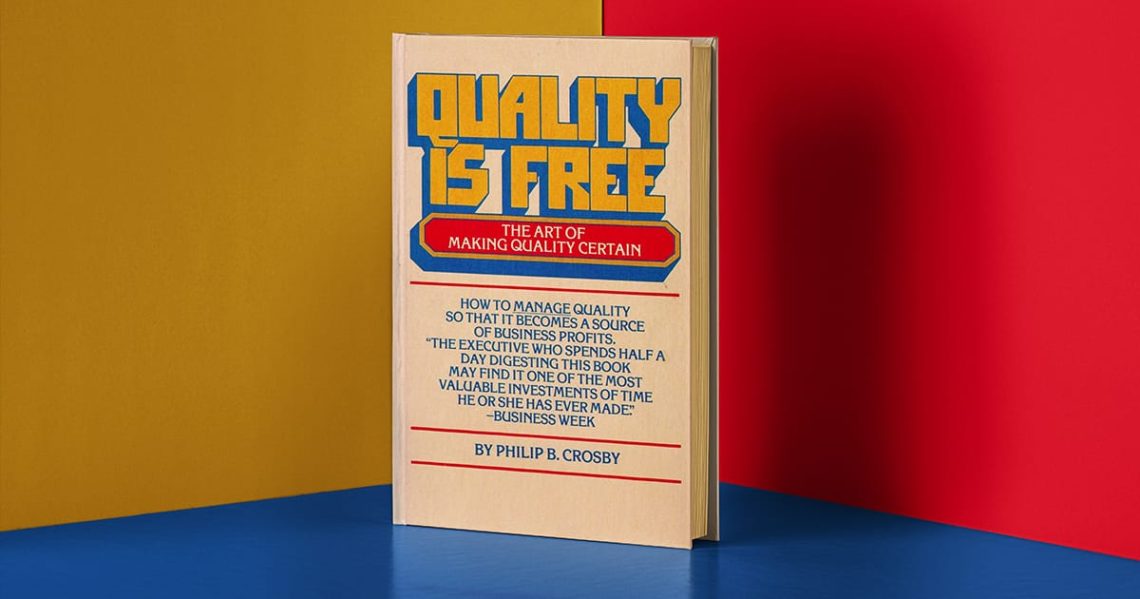Quality Is Free is a very old book by Phillip Crosby. It was written in 1979 with the old industrial model and factories in mind. However, the core concept of quality, how to achieve it and the main benefits of having a solid quality program can be easily extrapolated to the software industry, so that’s the reason I decided to read it. It actually has a lot of very interesting concepts, ideas and methodologies, some of which I’m trying to apply where I work. So, all in all, a good read.
Here are the notes I took while reading the book. They are not in any particular order or connected in any particular way. This isn’t supposed to be a summary, review or essay. It may even have some key information or examples missing. They are just thoughts and direct quotes that caught my attention and I felt like marking or writing down to try to retain them in my memory.
Most people feel that all problems are caused by other people, some feel that errors are inevitable and employees don’t give a damn about doing a good work. This couldn’t be more wrong.
Quality is free. What cost money are the “unquality” things and all the actions that involve not doing things right the first time.
Making quality certain
Top managers, who usually have expertise in one particular area and not in others, may or may not know what has to be done to achieve quality; or worse, they may feel (mistakenly) that they know, which can cause the most harm.
True quality is achieved through prevention, not post-control.
Management participation in quality is key. If management think people don’t care, they won’t.
Quality is neither abstract nor subjective. It’s just conformance to requirements.
Recognition to those who are able to maintain constant high-quality performances is very important.
Cost of sale raises quicker than your prices, so one of the best ways to increase profits is to eliminate or reduce costs. The best way to do that is by defect prevention.
Quality may not be what you think it is
Some incorrect assumptions about quality:
- It’s not related to goodness, luxury or relative worth. It just is conformance to requirements.
- Quality is not intangible. It can be measured as the saved expenses of not being compliant to the requirements the first time.
- Quality doesn’t cost.
- It isn’t just a “thing” in the manufacturing process. It’s in every single process of your company, specially in decision making and planning.
- Quality is doesn’t originate or is just a responsibility of the quality department. The problems should be “owned” by the ones causing them. The quality department is just a facilitator, not the one responsible for improving quality.
Quality management is a systematic way of guaranteeing that organized activities happen the way they are planned.
People at the bottom can contribute to deterioration, but not improvement. For quality management to be practical and achievable, it should start at the top.
The quality management maturity grid
Quality is not a result-oriented evaluation, but a planning operation.
Changing mindsets is the hardest management job. It is also where the opportunities lie and the money is.
The different stages of quality management maturity:
- Uncertainty: Top Management believe quality is like policing and catching “the bad guys” who are at fault. Its focus is on the who, instead of the what or why.
- Awakening: recognizing that quality management might work, but not willing to devote time or money to it. Minor short term goals may be achieved, but in the long term, efforts will dry out.
- Enlightenment: admission that problems are caused by top management itself. Resources are available to pursue a proper quality program.
- Wisdom: the quality program is un full effect. Here is where changes are made permanent.
- Certainty: quality managers are a vital part of the company. Problem detection works flawlessly.

Management understanding and attitude
“Won” doesn’t mean “kept”.
When it comes to the responsibility of managing a company or a team, you have to be prepared to admit that some of the problems might be caused by the individuals responsible for that management. Otherwise, corrective action will never happen.
What attitudes are present in each stage:
- Uncertainty
- Management expects them not to let anything that is “too” bad to get out of place.
- Do whatever you have to do to to find and solve today’s problems. Let tomorrow take care of itself.
- Awakening
- Is afraid of its commitment to the future. It recognizes there’s a better way out there, but won’t chase it right now.
- Enlightenment
- Better communication and less defensive stands
- Wisdom
- Focuses on not loosing the achieved practices and benefits
- Buck-a-day: what would have to be done to save $1 a day by eliminating one unnecessary expense a day. It quickly adds up if you do it with every employee.
- Certainty
- Error or problems rarely occur and when they do, they are treated with extreme severity so they don’t happen again.
Changing management’s attitudes
Peers are way more influential than staff.
Quality organizational status
Quality department functions
- Product acceptance
- Inspection (visual)
- Testing (functional)
- Supplier quality
- Supplier quality engineering
- Purchased goods acceptance
- Quality engineering
- Data analysis and status reporting
- Corrective measures and actions
- Planning
- Qualification of product, process and procedures
- Audit
- Quality education
Handling problems
People who feel involved and important perform better.
Cost of quality
Cost of quality: all efforts that go into doing work more than once. Such as
- Clerical work.
- Scraps.
- Warranty.
- After service.
- Complaint handling.
- Inspection and test.
- Other costs, such as more structural ones.
Quality improvement program
Implementing a successful quality improvement program takes time and requires a culture change. It also needs complete and continuous attention.
The 14 steps
- Management commitment
- For a Quality Improvement Team
- Specify how quality is measured
- Cost of quality evaluation
- Quality awareness (sharing with everyone how much non-quality is costing)
- Corrective action (at every level) planning
- Zero defect program (just what it sounds)
- Supervisor (mid-management) training
- Zero defect event (for remembrance)
- Goal setting (30/60/90 days goals. Specific and measurable)
- Error cause removal (workers list what is causing them to not be error free. The people responsible for decision making solve it. Problems should be addressed quickly)
- Recognition
- Quality councils
- Do it again
Management style
People are not interested in doing something just because they are told so. Communication has to be established and continually reinforced in order to keep employees informed and participating.
Management style checklist:
- Helping: ≠ cooperating. It involves giving, expecting nothing in return.
- Transmitting: what people see is what they think you are.
- Creating: creatively solving problems by breaking them down to their most basic aspects. Expand other’s ideas. Take old ideas and update them.
- Implementing: when given a task, analyze and “solve it” by your own devices instead of waiting for orders on what to do.
- Learning: adapting responses to previous experiences and new information.
- Leading
- Following
Case study
If you can find problems when they are little, you can remove them with almost no effort or expense. Better yet, if you can find why they happen, you can avoid them altogether.
The quality policy should be “perform exactly like the requirement or cause the requirement to change for it to reflect what we and our customers really need”.
Unless data is reported accurately, it is useless. It is only effective when it produces information people understand and use.
The time cost of fixing something should be multiplied by three: doing it wrong the first time + fixing it + the time fixing it could be used in something else. And this doesn’t even count the time spent in finding the error nor the error cost in itself.
Most of the people who have problems have created most of them through their attitudes.
Resourcefulness is the most valuable trait of a coordinator.





Comments by Nacho